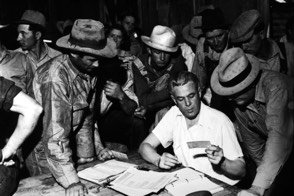Sign up for FlowVella
Sign up with FacebookAlready have an account? Sign in now
By registering you are agreeing to our
Terms of Service
Loading Flow


The 5 Parts of the EBA
Title I expanded presidential authority during banking crisis, including retroactive approval of the banking holiday and regulation of all banking functions, including “any transactions in foreign exchange, transfers of credit between or payments by banking institutions as defined by the President, and export, hoarding, melting, or earmarking of gold or silver coin.”
Title II gave the comptroller of the currency the power to restrict the operations of a bank with impaired assets and to appoint conservator, who “shall take possession of the books, records, and assets of every description of such bank, and take such action as may be necessary to conserve the assets of such bank pending further disposition of its business.”

The Emergency Banking Act was passed by the United States Congress in March 1933 in an attempt to stabilize the banking system.
EBA
